|
Lesson 1 FIRST AID
cpr
Cardiopulmonary resuscitation (CPR): First aid
Cardiopulmonary resuscitation (CPR) is a lifesaving technique useful in many
emergencies, including heart attack or near drowning, in which someone's
breathing or heartbeat has stopped. CPR involves a combination of mouth-to-mouth
rescue breathing and chest compression that keeps oxygenated blood flowing to
the brain and other vital organs until more definitive medical treatment can
restore a normal heart rhythm.
When the heart stops, the absence of oxygenated blood can cause irreparable
brain damage in only a few minutes. Death will occur within eight to 10 minutes.
Time is critical when you're helping an unconscious person who isn't breathing.
To learn CPR properly, take an accredited first-aid training course, including
CPR and how to use an automated external defibrillator (AED).
Before you begin
Assess the situation before starting CPR:
§
Is the person conscious or unconscious?
§
If the person appears unconscious, tap or shake his or her shoulder and ask
loudly, "Are you OK?"
§
If the person doesn't respond, call 911 (or your local emergency number), or
have someone else do it. But if you're alone and the victim is an infant or a
child age 1 to 8 who needs CPR, perform two minutes of CPR before calling for
help.
Remember the ABCs
Airway, Breathing and Circulation to remember the steps explained below.
AIRWAY: Clear the airway
1. Put the person
on his or her back on a firm surface.
2. Kneel next to
the person's neck and shoulders.
3. Open the
person's airway using the head tilt-chin lift. Put your palm on the person's
forehead and gently push down. Then with the other hand, gently lift the chin
forward to open the airway.
4. Check for normal
breathing, taking no more than 10 seconds: Look for chest motion, listen for
breath sounds, and feel for the person's breath on your cheek and ear. Do not
consider gasping to be normal breathing. If the person isn't breathing normally
or you aren't sure, begin mouth-to-mouth breathing.
BREATHING: Breathe for the person
Rescue breathing can be mouth-to-mouth breathing or mouth-to-nose breathing if
the mouth is seriously injured or can't be opened.
1. With the airway
open (using the head tilt-chin lift), pinch the nostrils shut for mouth-to-mouth
breathing and cover the person's mouth with yours, making a seal.
2. Prepare to give
two rescue breaths. Give the first rescue breath lasting one second and
watch to see if the chest rises. If it does rise, give the second breath. If the
chest doesn't rise, repeat the head tilt-chin lift and then give the second
breath.
3. Begin chest
compressions go to "CIRCULATION" below.
CIRCULATION: Restore blood circulation
1. Place the heel
of one hand over the center of the person's chest, between the nipples. Place
your other hand on top of the first hand. Keep your elbows straight and position
your shoulders directly above your hands.
2. Use your upper
body weight (not just your arms) as you push straight down on (compress) the
chest 1 1/2 to 2 inches. Push hard and push fast give two compressions per
second, or about 100 compressions per minute.
3. After 30
compressions, tilt the head back and lift the chin up to open the airway.
Prepare to give two rescue breaths. Pinch the nose shut and breathe into the
mouth for one second. If the chest rises, give a second rescue breath. If the
chest doesnt rise, repeat the head tilt-chin lift and then give the second
rescue breath. That's one cycle. If someone else is available, ask that person
to give two breaths after you do 30 compressions.
4. If the person
has not begun moving after five cycles (about two minutes) and an automated
external defibrillator (AED) is available, open the kit and follow the prompts.
If you're not trained to use an AED, a 911 operator may be able to guide you in
its use. Trained staff at many public places are also able to provide and use an
AED. Use pediatric pads, if available, for children ages 1 to 8. If pediatric
pads aren't available, use adult pads. Do not use an AED for infants younger
than age 1. If an AED isn't available, go to Number 5 below.
5. Continue CPR
until there are signs of movement or until emergency medical personnel take
over.
To perform CPR on a child:
The procedure for giving CPR to a child age 1 through 8 is essentially the same
as that for an adult. The differences are as follows:
§
Perform five cycles of compressions and breaths on the child this should take
about two minutes before calling 911 or the local emergency number, unless
someone else can call while you attend to the child.
§
Use only one hand to perform heart compressions.
§
Breathe more gently.
§
Use the same compression/breath rate as is used for adults: 30 compressions
followed by two breaths. This is one cycle. Following the two breaths,
immediately begin the next cycle of compressions and breaths. Continue until the
victim moves or help arrives.
To perform CPR on a baby:
Most cardiac arrests in infants occur from lack of oxygen, such as from drowning
or choking. If you know the infant has an airway obstruction, perform first aid
for choking. If you don't know why the infant isn't breathing, perform CPR.
To begin, assess the situation. Stroke the baby and watch for a response, such
as movement, but don't shake the child.
If there's no response, follow the ABC procedures below and time the call for
help as follows:
§
If you're the only rescuer and CPR is needed, do CPR for two minutes about
five cycles before calling 911 or your local emergency number.
§
If another person is available, have that person call for help immediately while
you attend to the baby.
AIRWAY: Clear the airway
1. Place the baby
on his or her back on firm, flat surface, such as a table. The floor or ground
also will do.
2. Gently tip the
head back by lifting the chin with one hand and pushing down on the forehead
with the other hand.
3. In no more than
10 seconds, put your ear near the baby's mouth and check for breathing: Look for
chest motion, listen for breath sounds, and feel for breath on your cheek and
ear.
If the infant isn't breathing, begin mouth-to-mouth breathing immediately.
BREATHING: Breathe for the infant
1. Cover the baby's
mouth and nose with your mouth.
2. Prepare to give
two rescue breaths. Use the strength of your cheeks to deliver gentle puffs of
air (instead of deep breaths from your lungs) to slowly breathe into the baby's
mouth one time, taking one second for the breath. Watch to see if the baby's
chest rises. If it does, give a second rescue breath. If the chest does not
rise, repeat the head tilt-chin lift and then give the second breath.
3. If the chest
still doesn't rise, examine the mouth to make sure no foreign material is
inside. If the object is seen, sweep it out with your finger. If the airway
seems blocked, perform first aid for a choking infant.
4. Begin chest
compressions go to "CIRCULATION" below.
CIRCULATION: Restore blood circulation
1. Imagine a
horizontal line drawn between the baby's nipples. Place two fingers of one hand
just below this line, in the center of the chest.
2. Gently compress
the chest to about one-third to one-half the depth of the chest.
3. Count aloud as
you pump in a fairly rapid rhythm. You should pump at a rate of about 100 times
a minute.
4. Give two breaths
after every 30 chest compressions.
5. Perform CPR for
about two minutes before calling for help unless someone else can make the call
while you attend to the baby.
6. Continue CPR
until you see signs of life or until a professional relieves you.
 to the links
to the links

Lesson 2
HUMAN BODY FUNCTIONS AND SYSTEMS
DIGESTIVE SYSTEM
BASICS OF DIGESTION
A fresh-baked apple pie is browning in the
oven. Just the sight and smell of it and the anticipation of eating it are
enough to make you start salivating and producing stomach acids. So even before
you take a bite, the digestive process has begun.
After the first steaming
morsel enters your mouth, the many organs of your digestive tract kick into high
gear. Here's a look at how your digestive system works, from top to bottom.
Mouth and salivary glands

After you take your first
bite of pie, your salivary glands produce enough digestive juices (saliva) to
begin breaking it down chemically. Besides the salivary glands in the lining of
your mouth, you have three pairs of larger salivary glands the parotid glands,
sublingual glands and the submandibular glands. Together they produce 1 to 3
pints of saliva a day.
Not all of the work is
chemical, though. As you savor the sweet apple tang, your teeth work to grind
the pie while your tongue mixes it with saliva. This combination transforms it
into a bolus a soft, moist, rounded mass suitable for swallowing.
Esophagus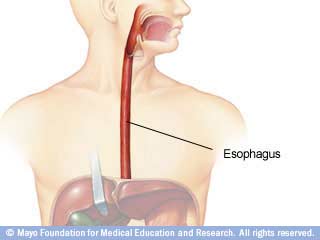
As you swallow that last bite
of pie, muscles in your mouth and throat propel it to your upper esophagus, the
tube that connects your throat to your stomach. In the wall of your esophagus,
muscles create synchronized waves one after another that propel the pie into
your stomach. In this process, called peristalsis, muscles behind the bolus of
pie contract, squeezing it forward, while muscles ahead of it relax, allowing it
to advance without resistance.
When the bolus reaches the
lower end of your esophagus, pressure from the food signals a muscular valve
the lower esophageal sphincter to open and let it enter your stomach.
Stomach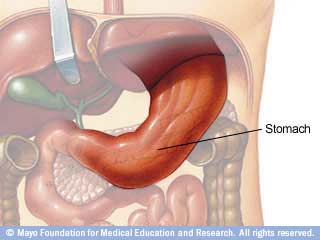
After entering your stomach,
the pie soon becomes unrecognizable. The stomach's wall, lined with three layers
of powerful muscles, begins churning and mixing it into smaller and smaller
pieces. Gastric juices, rich in acid and enzymes, pour out of glands that line
your stomach. The acid and enzymes help break down food into a thick, creamy
fluid called chyme.
Once the concoction is well
mixed, waves of muscle contractions propel it through the pyloric valve and into
the first section of your small intestine (duodenum). The pyloric valve releases
less than an eighth of an ounce of chyme at a time. The rest is held back for
more mixing.
Pancreas, liver and
gallbladder
In your duodenum, digestion
continues, as chyme from the stomach mixes with a variety of digestive juices
from your pancreas, liver and gallbladder:
§
Pancreas.
The pancreas produces digestive enzymes that help break down proteins,
carbohydrates, and fats. It also produces the hormones insulin and glucagon,
which help regulate the level of sugar (glucose) in your blood.
§
Liver.
The liver performs more than 500 functions, including storing nutrients,
filtering and processing chemicals in food, and producing bile, a solution that
helps digest fats and eliminate waste products.
§
Gallbladder.
The gallbladder stores and concentrates bile. As fatty food enters the upper
portion of your small intestine (the duodenum), the gallbladder contracts and
releases bile into the small intestine through a duct.
Small intestine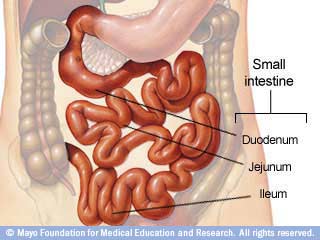
When bile and pancreatic
digestive juices mix with other juices secreted by the wall of your small
intestine, digestion shifts into high gear. What was once apple pie is propelled
into the second portion of your small intestine, the jejunum. Here it's further
broken down into smaller molecules of nutrients that can be absorbed. Then it
slides into the final and longest portion of your small intestine the ileum
where virtually all of the remaining nutrients are absorbed through the lining
of the ileum's wall.
What remains at the end of
the ileum is a combination of water, electrolytes such as sodium and chloride
and waste products, such as plant fiber and dead cells shed from the lining of
your digestive tract.
Large intestine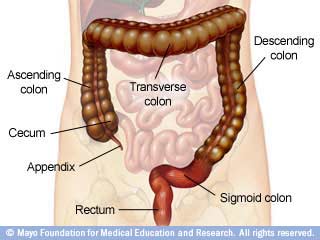
As this residue passes
through the colon, your body absorbs nearly all of the water, leaving a usually
soft but formed substance called stool. Muscles in the wall of your colon
separate the waste into small segments that are pushed into your lower colon and
rectum. As the rectal walls are stretched, they signal need for a bowel
movement.
When the sphincter muscles in
your anus relax, the rectal walls contract to increase pressure. Sometimes you
have to use your abdominal muscles, which press on the outside of the colon and
rectum. These coordinated muscle contractions expel the stool.
Healthy digestion
The types of food you
eat, the amount of exercise you get, the pace of your day and your level
of stress all can affect the health of your digestive system. Good
lifestyle habits can go a long way toward keeping your digestive system
on track:
§
Practice good eating
habits.
§
Maintain healthy weight.
§
Get regular exercise.
§
Control stress.
§
Limit alcohol and
tobacco.
§
Use medications
cautiously
.

|
CIRCULATORY
SYSTEM
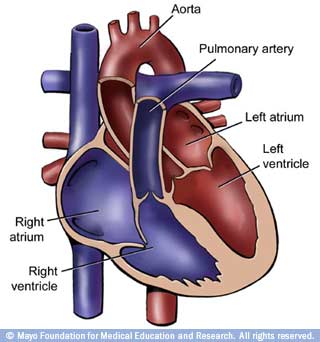
Your heart is a pump. It's a muscular organ about the size of your fist and
located slightly left of center in your chest.
Your heart is divided into the right and the left side. The division
protects oxygen-rich blood from mixing with oxygen-poor blood.
Together, your heart and blood vessels comprise your cardiovascular system,
which circulates blood and oxygen around your body. In fact:
§
Your heart pumps about 5 quarts of blood every minute.
§
And it beats about 100,000 times in one day that's about 35 million times
in a year.
Oxygen-poor blood, "blue blood," returns to the heart after circulating
through your body.
The right side of the heart, composed of the right atrium and ventricle,
collects and pumps blood to the lungs through the pulmonary arteries. The
lungs refresh the blood with a new supply of oxygen, making it turn red.
Oxygen-rich blood, "red blood," then enters the left side of the heart,
composed of the left atrium and ventricle, and is pumped through the aorta
to the body to supply tissues with oxygen.
Four valves within your heart keep your blood moving the right way.
The tricuspid, mitral, pulmonary and aortic valves work like gates on a
fence. They open only one way and only when pushed on. Each valve opens and
closes once per heartbeat or about once every second.
A beating heart contracts and relaxes. Contraction is called systole and
relaxing is called diastole.
During systole, your ventricles contract, forcing blood into the vessels
going to your lungs and body much like ketchup being forced out of a
squeeze bottle. The right ventricle contracts a little bit before the left
ventricle does.
Your ventricles then relax during diastole and are filled with blood coming
from the upper chambers, the left and right atria. The cycle then starts
over again.
Your heart is nourished by blood too. Blood vessels called coronary arteries
extend over the surface of your heart and branch into smaller capillaries.
Here you can see just the network of blood vessels that feed your heart with
oxygen-rich blood.
Your heart also has electrical wiring, which keeps it beating. Electrical
impulses begin high in the right atrium and travel through specialized
pathways to the ventricles, delivering the signal to pump.
The conduction system keeps your heart beating in a coordinated and normal
rhythm, which in turn keeps blood circulating. The continuous exchange of
oxygen-rich blood with oxygen-poor blood is what keeps you alive.
NERVOUS SYSTEM
Brain and nervous system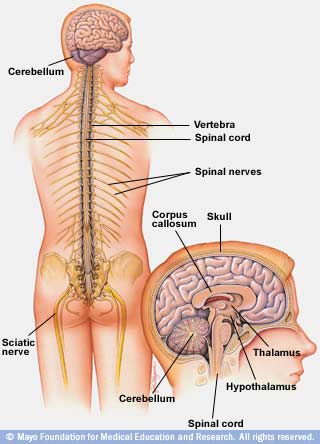
Your brain contains billions of nerve cells arranged in patterns that coordinate
thought, emotion, behavior, movement and sensation. A complicated highway system
of nerves connects your brain to the rest of your body, so communication can
occur in split seconds. Think about how fast you pull your hand back from a hot
stove. While all the parts of your brain work together, each part is responsible
for a specific function controlling everything from your heart rate to your
mood.
Cerebrum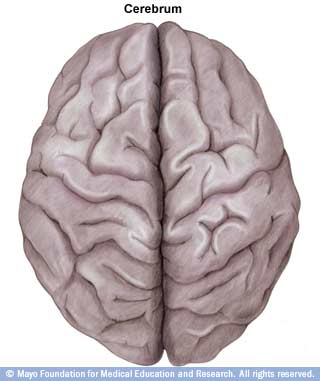
The cerebrum is the largest part of your brain. It's what you probably visualize
when you think of brains in general. The outermost layer of the cerebrum is the
cerebral cortex, the "gray matter" of the brain. Deep folds and wrinkles in the
brain increase the surface area of the gray matter, so more information can be
processed.
The cerebrum is divided into two halves (hemispheres) by a deep fissure. The
hemispheres communicate with each other through a thick tract of nerves, called
the corpus callosum, at the base of the fissure. In fact, messages to and from
one half of the body are usually handled by the opposite side of the brain.
Lobes of the brain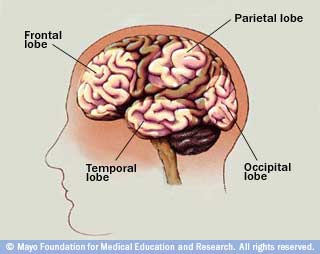
Each of your brain's hemispheres is divided into four lobes. The two frontal
lobes act as short-term storage sites for ideas, allowing you to consider more
than one idea at a time. One section of the frontal lobes helps control
voluntary movement, while a place in the left frontal lobe allows thoughts to be
transformed into words. The parietal lobes interpret sensory information, such
as taste, temperature and touch; they also help with reading and math. Occipital
lobes process images from the eyes and link that information with images stored
in memory. The temporal lobes translate information from the ears, including
music. The underside of the temporal lobe plays a crucial role in memory.
Cerebellum and brainstem
The brainstem links the brain to the spinal cord. It controls many functions
vital to life, such as heart rate, blood pressure and breathing. This area is
also important for sleep.
The cerebellum is a wrinkled ball of tissue below and behind the rest of your
brain. It works to combine sensory information from the eyes, ears and muscles
to help coordinate movement. Damage to the cerebellum can cause "intention
tremor," which is trembling of part of your body for example, your hand
occurring only when you try to move it.
Layers of protection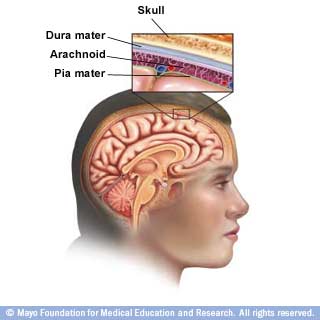
The brain is protected by three layers of membrane, called meninges, lying just
under the skull. The tough outer layer is called the dura mater, and the
delicate inner layer is the pia mater. The middle layer is the arachnoid, a
web-like structure filled with fluid that cushions the brain.
The inner brain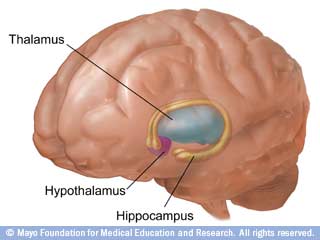
Structures deep within the brain control your emotions and memories. Known
collectively as the limbic system, these structures come in pairs, just like the
lobes in the brain's cerebrum. Each part of the limbic system is duplicated in
the opposite half of the brain.
The thalamus acts as a gatekeeper for messages passed between the spinal cord
and the cerebral hemispheres. The pea-sized hypothalamus controls emotions such
as exhilaration and anger. It also regulates your body's temperature and is
responsible for crucial urges such as eating, sleeping and sexual behavior.
The hippocampus is a memory indexer, sending memories to be stored in
appropriate sections of the cerebrum and then recalling them when necessary.
Peripheral nervous system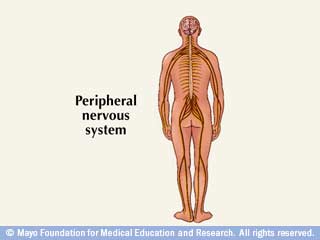
The peripheral nervous system is all the nerves in your body, aside from the
ones in your brain and spinal cord. It acts as a communication relay between
your brain and your extremities. For example, if you touch a hot stove, the pain
signals travel from your finger to your brain in a split second. In just as
short a time, your brain tells the muscles in your arm and hand to snatch your
finger off the hot stove.
Nerve cells
Nerve cells (neurons) have two main types of branches coming off their cell
bodies. Dendrites receive incoming messages from other nerve cells. Axons carry
outgoing signals from the cell body to other cells such as a nearby neuron or
muscle cell.
Interconnected with each other, neurons are able to provide efficient,
lightning-fast communication.
Neurotransmitters 
A neuron communicates with other cells through electrical impulses, which occur
when the nerve cell is stimulated. Within a neuron, the impulse moves to the tip
of an axon and causes the release of neurotransmitters, chemicals that act as
messengers.
These neurotransmitters pass through the synapse, the tiny gap between two nerve
cells, and attach to receptors on the receiving cell. This process is repeated
from neuron to neuron, as the impulse travels to its destination.
This intricate web of communication allows you to move, think, feel and
communicate. It keeps your heart beating. It affects your mood. In short, this
wondrous process is the foundation of your physical, mental and emotional life.
It makes you who you are.


Lesson 3
MUSCULAR SYSTEM
BODY- TRAPS AND LATS
  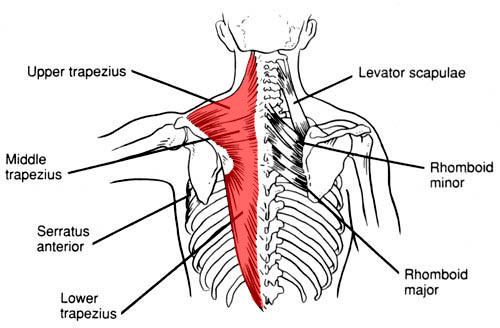
ARM-BICEPS AND TRICEPS
  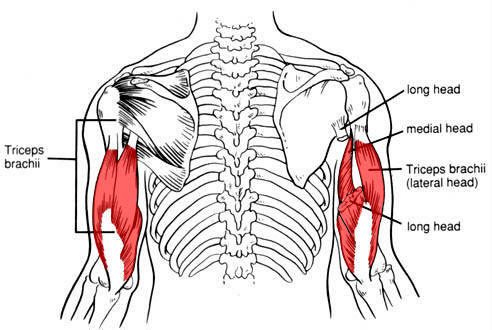
LEG- QUADS, HAMSTRING AND THIGH
 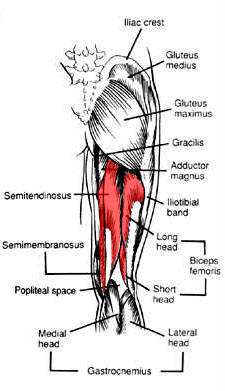 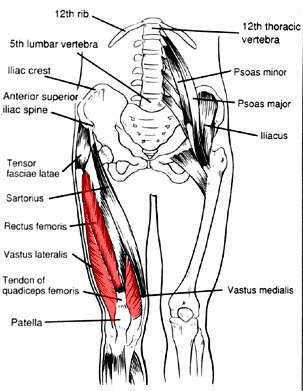


Lesson 4 EYE
ANATOMY
The eye
A look inside your eyes
 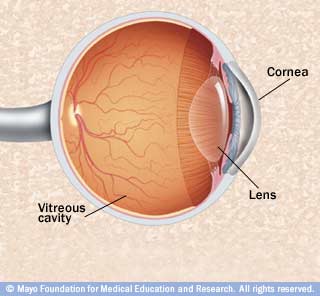
 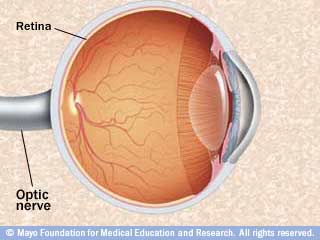
Your eyes are a small part of your body each eyeball is about an inch in
diameter. Yet your eyes play a big role in your life. With them you experience
the shape, color and motion of your surroundings. They alert you to danger or to
the unexpected. You rely on them to help you explore and learn.
Here's a look at the various parts of the eye and how they work together to help
you see the world around you. Each part plays an essential role in your eyes'
healthy functioning.
Eyelids
Upper and lower eyelids protect the front of your eyeball (orbit) by blocking
out foreign objects and bright light that can damage your eye. Your eyelids
involuntarily open and shut (blink) every few seconds to help protect your
eyeball. You can, of course, blink intentionally as well.
With each blink, a tiny bit of tear fluid comes out of a gland near each eye.
The lubricant washes away germs, dust, eyelashes or other foreign objects and
keeps your eyes from drying out.
The front of your eye
Three parts make up the front of your eye:
§
Sclera.
The white of your eye is actually a tough, leathery coating that helps form the
spherical shape of your eyeball and protects the delicate internal structures of
your eye.
§
Pupil.
The dark spot at the center of your eye is a hole that allows light to pass into
your eye.
§
Iris.
The colored part of your eye contains a ring of muscle fibers that can expand or
contract the size of your pupil, controlling the amount of light entering your
eyeball.
A thin transparent tissue called the conjunctiva covers the sclera of your eye.
The blood vessels that are often visible in the white part of your eye run
through your eye's conjunctiva.
Inside your eye
Behind the scenes, other parts of your eye are working to help you see:
§
Cornea.
Your cornea is a protective dome of clear tissue over the front of your eye. It
functions as a convex surface that helps focus the light rays before they are
fine-tuned by the lens.
§
Lens.
Your lens is a clear, elliptical structure about the size and shape of an M&M'S
candy. The curvature of your lens changes to sharpen the focus of whatever
you're looking at.
§
Vitreous cavity.
The vitreous cavity extends from the back of the lens to the back of your
eyeball. It's filled with a clear, jelly-like substance that allows light to
pass through. It also maintains the shape of your eyeball.
The back of your eye
Structures at the back of your eye help complete the vision process:
§
Retina.
Your retina is a thin layer of tissue that lines the back inner wall of your
eyeball. Your retina consists of millions of light-sensitive cells and nerve
cells that capture the images focused onto them by your cornea and lens. When
light hits these cells, electrical impulses are generated and carried to your
optic nerve.
§
Optic nerve.
Your optic nerve carries information gathered by your retina to your brain via a
bundle of more than 1 million nerve fibers.
How your eyes move
Each eyeball has six muscles attached to the sclera five are seen from this
angle allowing you to move both eyes and track an object without necessarily
turning your head. These eye muscles, working individually or together, allow
you to shift your field of gaze left, right, up, down and diagonally. Your brain
coordinates these eye movements, so your eyes move together when tracking an
object.


Lesson 5 VIOLIN
techniques
HOLDING THE BOW

BOYS PLAYING
THAI BOY PLAYING
GIRL PLAYING
BOY PLAYING

CONCERTS
VIVALDI CONCERTO NO 1 SPRING
VIBRATO
5-Yr-Old Violinist Bach Concerto No. 2 E-Major
Violin Bazzini

others
RAPHA
VIOLIN LESSONS
CLEANING YOUR VIOLIN


Lesson 6
HEALTH WATCH
Healthy Plan
Healthy Plan
for stress free living
1. Exercise
for at least 1 hour, 3 times a week
Pick your
favorite sport or join a good fitness center, and make sure you start according
to your current fitness level. It helps work the heart muscle, hence sending
more nutrients and oxygen to the whole body.
2. Eat more
vegetables and fruits
There's
nothing better than consuming food in its natural state, the way nature always
intended it to be. They are full of natural goodness like fibers, vitamins,
minerals, anti-oxidants and a wide array of phytonutrients.
3. Drink
more water
As you become
more active and sweat more, you need to increase your water intake to keep well
hydrated. Two to three liters of water should do just fine. Please note that
caffeine blocks absorption of certain vital nutrients, especially minerals that
your body needs to function properly. Women's bodies do not clear caffeine as
quickly as men's. Hence you will most likely still get the effect of caffeine
until late at night. Iron is one important nutrient for women to form new red
blood cells whose absorption is hampered by caffeine. Lack of iron has been
associated with dizziness, lethargy and poor immune system.
4. Minimize
or avoid consumption of fat, sugars, flour, margarine, salt, butter and alcohol
They contain a
lot of calories and disrupt your intestinal health but offer none-to-little
nutritional value. Be aware that they may come in various forms of food and
beverages.
5. Eat more
lean protein
Chicken
breast, egg-white, soy (including tempeh and tofu), non-fat dairy products
(including milk, yoghurt, cheese, protein powder), lean red meat are your
proteins of choice, unless you are allergic to any particular one. Make sure you
have them prepared with minimum inclusion of items in point number four.
6. Don't
skip your meals
Three square
meals with a couple of healthy snacks will do wonders. Make an attempt to eat at
exactly the same time every day. It helps to build a better bio-rhythm to your
days and life. Besides it keeps your metabolism and blood-sugar stable, hence
keeping the lard off your waist, belly, under arm and thighs.
7. Drink
tea instead
It's calming,
relaxing, and yet one of the most economical ways to activate the fat-burning
process, protect yourself from harmful free-radicals and build-up of
cholesterol.
8. Have
your daily multivitamins and minerals
It helps give
you a sense of assurance that all your micro-nutrient needs are covered, despite
variations of food intake.
9. Rest
well
When it comes
to resting, quality is as important as quantity. A solid six to eight hours of
sleep, supplemented by a 20-minute power nap will do you good. Meditation or a
warm bath may be a good prelude to a good night sleep.
10. Involve
your family in all of the action plans above
Last but not
least, allow me to give closure to this installment with a quote from a renowned
educational psychologist, Patricia Alexander:
"He/she who says 'I don't have enough time or
money to take care of my health' will soon find him/herself spending a lot of
time and money being taken care of due to illness." Another version
"Do not work your health for wealth and pay your wealth for health."

Reasons for sleeping and waking up early.
Evening at 9 - 11pm:
is the time for eliminating unnecessary/ toxic chemicals (detoxification)
from the antibody system (lymph nodes). This time duration should be spent
by relaxing or listening to music. If during this time a housewife is still
in an unrelaxed state such as washing the dishes or monitoring children
doing their homework, this will have a negative impact on health.
Evening at 11pm - 1am:
is the detoxification process in the liver, and ideally should be done in a
deep sleep state.
Early morning 1 - 3am:
detoxification process in the gall, also ideally done in a deep sleep state.
Early morning 3 - 5am:
detoxification in the lungs. Therefore there will sometimes be a severe cough
for cough sufferers during this time. Since the detoxification process had
reached the respiratory tract, there is no need to take cough medicine so as not
to
interfere with toxin removal process.
Morning 5 - 7am:
detoxification in the colon, you should empty your bowel.
Morning 7 - 9am:
absorption of nutrients in the small intestine, you should
be having breakfast at this time. Breakfast should be earlier, before 6:30am,
for those who are sick.
Breakfast before 7:30am is very beneficial to those
wanting to stay fit.
Those who always skip breakfast, they should change their habits, and it is
still better to eat breakfast late until 9 - 10am rather than no meal at all.
Sleeping
so late and waking up too late will disrupt the process of removing unnecessary
chemicals. Aside from that, midnight to 4:00 am is the time when the bone marrow
produces blood. Therefore, have a good sleep and don't sleep late.
TAKE CARE ABOUT YOUR HEALTH
Live Life Without Limits!

The top five cancer-causing foods are:
1. Hot dogs
Because they are high in nitrates, the Cancer Prevention Coalition advises that
children eat no more than 12 hot dogs a month. If you can't live without hot
dogs, buy those made without sodium nitrate.

2. Processed meats and bacon
Also high in the same sodium nitrates found in hot dogs, bacon, and other
processed meats raise the risk of heart disease. The saturated fat in bacon also
contributes to cancer.

3. Doughnuts
Doughnuts are cancer-causing double trouble. First, they are made with white
flour, sugar, and hydrogenated oils, then fried at high temperatures. Doughnuts,
says Adams , may be the worst food you can possibly eat to raise your risk of
cancer.

4. French fries
Like doughnuts, French fries are made with hydrogenated oils and then fried at
high temperatures. They also contain cancer- causing acryl amides which occur
during the frying process. They should be called cancer fries, not French fries,
said Adams .
 5.
Chips, crackers, and cookies 5.
Chips, crackers, and cookies
All are usually made with white flour and sugar. Even the ones whose labels
claim to be free of trans-fats generally contain small amounts of trans-fats.

BRAIN
DAMAGING HABITS
1. No Breakfast
People who do not take breakfast are going to have a lower blood sugar level.
This leads to an insufficient supply of nutrients to the brain causing brain
degeneration.
2. Overeating
It causes hardening of the brain arteries, leading to a decrease in mental
power.
3. Smoking
It causes multiple brain shrinkage and may lead to Alzheimer disease.
4. High Sugar consumption
Too much sugar will interrupt the absorption of proteins and nutrients causing
malnutrition and may interfere with brain development.
5. Air Pollution
The brain is the largest oxygen consumer in our body. Inhaling polluted air
decreases the supply of oxygen to the brain, bringing about a decrease in brain
efficiency.
6. Sleep Deprivation
Sleep allows our brain to rest. Long term deprivation from sleep will accelerate
the death of brain cells.
7. Head covered while sleeping
Sleeping with the head covered increases the concentration of carbon dioxide and
decrease concentration of oxygen that may lead to brain damaging effects.
8. Working your brain during illness
Working hard or studying with sickness may lead to a decrease in effectiveness
of the brain as well as damage the brain.
9. Lacking in stimulating thoughts
Thinking is the best way to train our brain, lacking in brain stimulation
thoughts may cause brain shrinkage.
10. Talking Rarely
Intellectual conversations will promote the efficiency of the brain
------------
--------- --------- --------- --------- --------- --------- --------- ---------
-------

The main causes of liver damage are:
1. Sleeping too late and waking up too late are main cause.
2. Not urinating in the morning.
3. Too much eating.
4. Skipping breakfast.
5. Consuming too much medication.
6. Consuming too much preservatives, additives, food coloring, and artificial
sweetener.
7. Consuming unhealthy cooking oil. As much as possible reduce cooking oil use
when frying, which includes even the best cooking oils like olive oil. Do not
consume fried foods when you are tired, except if the body is very fit.
8. Consuming raw (overly done) foods also add to the burden of liver.
Veggies should be eaten raw or cooked 3-5 parts. Fried veggies should be
finished in one sitting, do not store.
We should prevent this without necessarily spending more. We just have to adopt
a good daily lifestyle and eating habits. Maintaining good eating habits and
time condition are very important for our bodies to absorb and get rid of
unnecessary chemicals according to "schedule."



Lesson7
BE READY -NATURAL
DISASTERS
 to
the links to
the links

Lesson 8 KUNG FU PANDA

     
Kung Fu Panda
is a 2008 animated film about a panda who learns martial arts and then uses this
new ability to fight his enemies.
Directed by
Mark Osborne
and
w:John Stevenson.
Written by
Jonathan Aibel
and
Glenn Berger.
Tag line of the movie :
Prepare
for Awesomeness, Pandamonium Begins
1 Po
2 Shifu
3
Master Tigress
4 Tai Lung
5
Wu Gui
6 Dialogue
7
Taglines
8
Cast
 Get
ready to feel the Thunder!
Get
ready to feel the Thunder!
 Skadoosh!
Skadoosh!
 I
sucked more than anyone in the history of martial arts in the history of China
in the history of sucking!
I
sucked more than anyone in the history of martial arts in the history of China
in the history of sucking!
 Careful that soup is sharp!
Careful that soup is sharp!
 Don't tempt me!
Don't tempt me!
 Legs of Lightning!
Legs of Lightning!
 I
LOVE KUNG FU!!!!!
I
LOVE KUNG FU!!!!!
 Kung Fu on the Loose!
Kung Fu on the Loose!
 I'm
not just a big fat panda. I'm THE big fat panda.
I'm
not just a big fat panda. I'm THE big fat panda.
 He
was so deadly in fact that his enemies would go blind from overexposure to pure
awesomeness!
He
was so deadly in fact that his enemies would go blind from overexposure to pure
awesomeness!
 (smugly)Oh, you know this hold?
(smugly)Oh, you know this hold?
 (To
Po) When you focus on Kung Fu... when you concentrate... you stink.
(To
Po) When you focus on Kung Fu... when you concentrate... you stink.
 That flabby panda is not the Dragon Warrior!
That flabby panda is not the Dragon Warrior!
 You
have done well, Panda.
You
have done well, Panda.
 (talking to Po)
I'm not dying, you idiot! Er, I mean, Dragon Warrior... I am simply at peace.
(talking to Po)
I'm not dying, you idiot! Er, I mean, Dragon Warrior... I am simply at peace.
 Po,
you're alive?... Either that or we're both dead.
Po,
you're alive?... Either that or we're both dead.
 Do
you want to learn Kung fu!
Do
you want to learn Kung fu!
 Let's begin.
Let's begin.
 (Performing Wushii Finger Hold) You know what's the hardest thing about this
hold? Cleaning up afterwards.
(Performing Wushii Finger Hold) You know what's the hardest thing about this
hold? Cleaning up afterwards.
 It
is said that the Dragon Warrior can survive for months off nothing but the dew
of a single ginko leaf and the energy of the universe.
It
is said that the Dragon Warrior can survive for months off nothing but the dew
of a single ginko leaf and the energy of the universe.
 Master, let us battle Tai Lung. It is what you trained us for.
Master, let us battle Tai Lung. It is what you trained us for.
 Don't try and stop me!
Don't try and stop me!
 I
don't want your apology! I want my scroll!
I
don't want your apology! I want my scroll!
 So
that is his name. Po. Finally! A worthy opponent! Our battle will be legendary.
So
that is his name. Po. Finally! A worthy opponent! Our battle will be legendary.
 Tell me how proud you are, Shifu! Tell me! Tell me!
Tell me how proud you are, Shifu! Tell me! Tell me!
 (Upon seeing Po) He's a panda? You're a Panda? What are you going to do, big
guy? Sit on me?
(Upon seeing Po) He's a panda? You're a Panda? What are you going to do, big
guy? Sit on me?
 You're nothing but a big... fat... panda!
You're nothing but a big... fat... panda!
 (While held under the Wushii Finger Hold)
The Wushii finger hold! You're bluffing. You're bluffing! Shifu didn't teach you
that!
(While held under the Wushii Finger Hold)
The Wushii finger hold! You're bluffing. You're bluffing! Shifu didn't teach you
that!
 There is a saying. Yesterday is history, tomorrow is a mystery, but today is a
gift. That is why we call it the present.
There is a saying. Yesterday is history, tomorrow is a mystery, but today is a
gift. That is why we call it the present.
 There are no accidents.
There are no accidents.
 I
sense the Dragon Warrior is among us...
I
sense the Dragon Warrior is among us...
 The
universe has brought us the Dragon Warrior!
The
universe has brought us the Dragon Warrior!
 No.
You just need to believe.
No.
You just need to believe.
Tai Lung:
What are you going to do, big guy? Sit on me?
Po:
Don't tempt me.
Tai Lung:
You're nothing but a big... fat... panda! (Po grabs his finger)
Po:
I'm not just a big fat panda. I'm THE big fat panda.
(Po had grabbed some rubble from a plate Tigress just broke)
Shifu:
Put that back! The only souvenirs we collect here are bloody knuckles and broken
bones!
[first lines]
Po:
Legend tells of a legendary warrior whose kung fu skills were the stuff of
legend.
Viper:
Are you ready?
Po:
I was born ready- (Viper proceeds to beat Po up)
Viper:
I'm sorry, brother! I thought you said you were ready!
Po:
That was awesome! Let's go again!
(During Po's dream sequence)
Female Bystander:
He's so attractive!
Bar owner:
How can we ever repay you?
Dream Po:
There is no price for awesomeness. Or attractiveness.
Tigress:
You would think that Master Oogway would choose someone who actually knows kung
fu.
Crane:
Or be able to touch his toes.
Monkey:
Or even see his toes.
Oogway:
There are no accidents.
Shifu:
Yes,yes,I know. You said that already. Twice.
Oogway:
Well,that was no accident either.
Shifu:
(sighs)Thrice.
Po:
Isn't there, like, a Level Zero I can start off with?
Shifu:
Level Zero? There...IS no Level Zero.
Po:
Well how about I start on this! (Walks over to the punching bag like object)
Shifu:
That? We use that for training children and proping the door open when it's hot!
Po:
Perfect! (Notices the Furious Five watching him with curious expressions)
Eh...you just want me to wait until they go back on their own thing or...
Shifu:
Never mind them, go on, hit it.
Po:
Eh...okay...(Starts doing quick movements with his feet and mumbling to
himself)
Shifu:
Just hit it!
Po:
Right....(Taps it, making it wobble)
Shifu:
...Perhaps a little harder?
Po:
Right...(Hits it harder, making it lean back a lot) How's th-- (is hit
by it and sent flying into the moving ropes and swinging pendulums, only to be
thrusted into Crane's tilting bowl, hitting his head several times until it tips
over into the moving arm guard section, where it sets off a chain reaction that
causes one to hit him in the groin) Ooooo-hoo-hoo! My tenders...(Slowly
starts to move, activating the arms and smacking him into the fire floor area.
The camera pans back to Shifu and the Furious Five, and we hear the fire
activate and Po screaming. He slumps over next to Shifu, burnt and charred)
How did I do?
Shifu:
There is now a Level Zero. (Puts out a flame on top of Po's head)
(Po is making dinner for The Furious Five)
Po:
So then I said that you may be the scariest bandit in the Hanzin Province, but
you're a lousy tipper!
Crane:
Really? So how did you get out of there alive?
Po:
I didn't actually say that... but I thought it in my mind. If he could read
minds he be like, "What?" Order up.
Tigress:
It is said that the Dragon Warrior can survive off the dew of a single Ginko
leaf and all the energy of the universe.
Po:
I'm gonna need a lot more than dew, and, uh, universe juice. (he slurps his
noodles, with one hanging over his nose; everyone laughs) What?
Mantis:
Oh, nothing, Master Shifu. (everyone laughs again.)
Po
(impersonating Master Shifu):
You will never be the Dragon Warrior unless you lose 500 pounds and brush your
teeth. (The Furious Five, except Tigress, laugh) What is that noise
you're making? Laughter? I have never heard of it! Work hard, Panda, and maybe
someday you will have ears like mine! (he brings two bowls up to his head to
mimick ears; the Furious Five laugh, but stop and see Shifu behind Po) Ears.
What, not working for you?
Monkey
(whispering): It's Shifu!
(Mantis is giving Po acupuncture)
Mantis:
It's just hard to find the right stress points under all this...
Po:
Fat?
Mantis:
Fur. I was gonna say fur. Honest.
Po:
The Sword of Heroes! Said to be so sharp you can get cut just by looking at -
Ow!
Tai Lung:
The Wuxi finger hold!
Po:
Oh, you know this hold?
Tai Lung:
You're bluffing. You're bluffing! Shifu didn't teach you that!
Po:
You're right. He didn't. I figured it out on my own. (Po then flexes his pinky
finger) Skadoosh!
Oogway:
Look at this tree, Shifu. (Indicates the Peach Tree of Heavenly Wisdom) I
cannot make it blossom when it suits me, nor make it bear fruit before its time.
Shifu:
But there are things we can control! (Slams a fist into the tree, making
several peaches fall around them) I can control where the fruit will fall!
(Catches a peach, cuts it in half, takes the pit and slams it into the
ground) And I can control where to plant the seed! That is no illusion,
Master!
Oogway:
Ah,yes. But no matter what you do, that seed will grow to be a peach tree. You
may wish for an apple or an orange, but you will get a peach.
(After Shifu keeps stealing Po's dumplings at a picnic)
Shifu:
You are free to eat.
Po:
AM I !?
Shifu:
ARE YOU !? (Chopstick battle begins)
Shifu:
Our only hope is the Dragon Warrior.
Tigress:
The panda?
Shifu:
Yes, the panda!
Tigress:
Master, please! [pushes her chair out] Let us stop Tai Lung. This is what
you've trained us for!
Shifu:
No! It is not your destiny to defeat Tai Lung, it is his!
[points at Po, then realizes he's not there] Where'd he go? [cut to where
Po is running down the stairs, screaming, only to be stopped by Shifu] You
cannot leave! A real warrior never quits!
Po:
Watch me! [tries to run down the stairs, but Shifu uses the stick to turn Po
around] Come on! How am I supposed to beat Tai Lung? I can't even beat you
to the stairs!
Shifu:
You will beat him because you are the Dragon Warrior! [pokes Po in his
stomach]
Po:
You don't believe that! [Shifu swipes at his hand with Oogway's stick]
You never believed that! From the first moment I got here, you've been trying to
get rid of me! [Shifu knocks him to the ground]
Shifu:
Yes! I was! But now I ask you to trust in your master... as I have come to trust
in mine.
Po:
You're not my master. And I'm not the Dragon Warrior.
Shifu:
Then why didn't you quit? You knew I was trying to get rid of you, yet you
stayed!
Po:
Yeah, I stayed. I stayed because everytime you threw a brick at my head or said
I smelled, it hurt, but it could never hurt more than every day of my life just
being me. I stayed because I thought if anyone can change me, can make me... not
me, it was you! The greatest kung fu teacher in all of China!
Shifu:
I can change you! I can turn you into the Dragon Warrior! And I will!
Po:
Come on! Tai Lung is on his way here right now! And even if it takes him a
hundred years to get here, how are you gonna change this into the
Dragon Warrior? Huh? How?... How?... How?!?
Shifu:
I don't know!! [sighs] I don't know.
Po:
[sighs and frowns sadly] That's what I thought.
Tigress:
[after Tigress lectures Po and he makes a weird facial expression]
Oh,that's it! [about to punch him]
Mantis:
Wait, wait! My fault! I accidentally tweaked his facial nerve! [Po falls over
with his back full of needles] ...And I may have also stopped his heart.
Tai Lung
(leaning on the bridge): Where's the Dragon Warrior?
Tigress:
How do you know you're not looking at her? (Tai Lung laughs)
Tai Lung:
You think I'm a fool? I know you're not the Dragon Warrior. None of you.
(the Furious Five) I heard how he fell out of the sky on a ball of fire.
That he's a warrior unlike anything the world has ever seen.
Monkey:
Po?
Tai Lung:
So that is his name. Po. Finally! A worthy opponent. Our battle will be
legendary.
Po
(in awe): No! The legendary Urn of Whispering Warriors; said to contain
the souls of the entire Tenshu Army! [pauses before whispering] Hello?
Shifu:
Have you finished sight-seeing? [Po gasps]
Po:(Thinks
the urn is talking to him) Sorry, I should've come to see you first.
Shifu:
My patience is wearing thin.
Po:
Oh, well it's not like you were going anywhere.
Shifu:
Turn around.
Po bounces down the palace steps]
Tigress:
If he's smart, he won't come back up those stairs.
Monkey:
Yet he will.
Viper:
He'll never stop trying, will he?
Mantis:
He'll never stop bouncing, I can tell you that.
[In Po's dream sequence]
Gang Boss:
I see you like to chew. Maybe you should chew on my fist!
Shifu:
I have...it- it's very bad news!!
Oogway:
Ah, Shifu. There is just news- there is no good or bad.
Shifu:
Master, your vision...your vision was right! Tai Lung has escaped from prison!
He's on his way! (pause)
Oogway:
That is bad news. If you do not believe that the Dragon Warrior can stop
him.
Po:
I'm sorry, Dad.
Mr. Ping:
"Sorry" doesn't make the noodles, son.
Oogway:
[walking towards Po] Ah! It seems that you have found the Sacred Peach
Tree of Heavenly Wisdom!
Po:
[Po turns around with a lot of peaches stuffed in his mouth] Oh! Is that
what this is? I'm so sorry! I just thought it was a regular peach tree!
Po:
[After defeating Tai Lung] No, Master, I'm not dead... I defeated Tai
Lung!
Shifu:
You did? Wow...It is just as Oogway...foretold... You are the Dragon Warrior.
You have brought peace...to this valley... And...and to me... Thank you... Thank
you...Po... Thank you... Thank you... [Slumps over, as if dead]
Po:
No! Master! No, no, no, no! Shifu! Don't die!
Shifu
(angrily): I'm not dying, you idiot! - Er, I mean, Dragon Warrior... I am
simply at peace... Finally.
Po:
[Final Lines of the Movie, to Shifu, who is resting after his battle with Tai
Lung]...Wanna get something to eat?
Shifu:
[Pause] Yeah.
Shifu:
When you focus on kung fu, when you concentrate...you stink. [Po frowns]
But perhaps that is my fault. I cannot train you the way I have trained the
Five. I now see that the way to get through to you is with this. [pulls out a
bowl of dumplings]
Po:
Oh great, 'cause I am hungry!
Shifu:
[laughs] Good. When you have been trained, you may eat. Let's begin.
yesterday is history,tomorrow is mystery today is a gift that"s why it is called
present.
Cast
Jack Black
Po
Dustin Hoffman
Shifu
Angelina Jolie
Tigress
Ian McShane
- Tai Lung
Lucy Liu
- Viper
Jackie Chan
- Monkey
Seth Rogen
Mantis
David Cross
- Crane
Randall Duk Kim
- Oogway

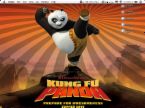
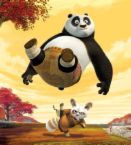



Lesson 9
Official mascots
The Official Mascots of the
Beijing 2008 Olympic Games
Like the Five Olympic Rings from which they draw their color and inspiration,
Fuwa will serve as the Official Mascots of Beijing 2008 Olympic Games, carrying
a message of friendship and peace -- and good wishes from China -- to children
all over the world.
Designed to express the playful qualities of five little children who form an
intimate circle of friends, Fuwa also embody the natural characteristics of four
of China's most popular animals
-- the Fish, the Panda, the Tibetan Antelope, the Swallow -- and the Olympic
Flame.
Each of Fuwa has a rhyming two-syllable name -- a traditional way of expressing
affection for children in China.
Beibei is the Fish,
Jingjing is the Panda,
Huanhuan is the Olympic Flame,
Yingying is the Tibetan Antelope and
Nini is the Swallow.
When you put their names together --
Bei Jing Huan Ying Ni
-- they say "Welcome to Beijing,"
offering a warm invitation that reflects the mission of Fuwa as young
ambassadors for the Olympic Games.
Fuwa also embody both the landscape and the dreams and aspirations of people
from every part of the vast country of China. In their origins and their
headpieces, you can see the five elements of nature -- the sea, forest, fire,
earth and sky -- all stylistically rendered in ways that represent the deep
traditional influences of Chinese folk art and ornamentation.
Spreading Traditional Chinese Good Wishes Wherever They Go
In the ancient culture of China, there is a grand tradition of spreading good
wishes through signs and symbols. Each of Fuwa symbolizes a different blessing
-- and will honor this tradition by carrying their good wishes to the children
of the world. Prosperity, happiness, passion, health and good luck will be
spread to every continent as Fuwa carry their invitation to Beijing 2008 to
every part of the globe. At the heart of their mission -- and through all of
their work -- Fuwa will seek to unite the world in peace and friendship through
the Olympic spirit. Dedicated to helping Beijing 2008 spread its theme of One
World, One Dream to every continent, Fuwa reflect the deep desire of the Chinese
people to reach out to the world in friendship through the Games -- and to
invite every man, woman and child to take part in the great celebration of human
solidarity that China will host in the light of the flame in 2008.
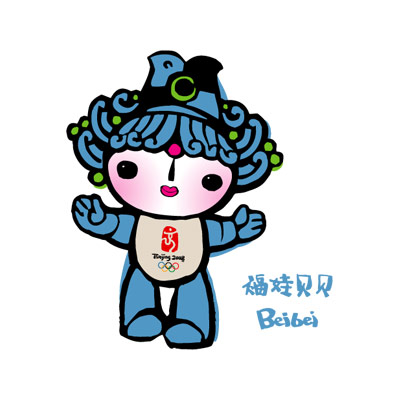 In
China's traditional culture and art, the fish and water designs are symbols
of prosperity and harvest. And so Beibei carries the blessing of prosperity.
A fish is also a symbol of surplus in Chinese culture, another measure of a
good year and a good life.The ornamental lines of the water-wave designs are
taken from well-known Chinese paintings of the past. Among Fuwa, Beibei is
known to be gentle and pure. Strong in water sports, she reflects the blue
Olympic ring. In
China's traditional culture and art, the fish and water designs are symbols
of prosperity and harvest. And so Beibei carries the blessing of prosperity.
A fish is also a symbol of surplus in Chinese culture, another measure of a
good year and a good life.The ornamental lines of the water-wave designs are
taken from well-known Chinese paintings of the past. Among Fuwa, Beibei is
known to be gentle and pure. Strong in water sports, she reflects the blue
Olympic ring.
 Jingjing
makes children smile -- and that's why he brings the blessing of happiness
wherever he goes. You can see his joy in the charming naivety of his dancing
pose and the lovely wave of his black and white fur. As a national treasure
and a protected species, pandas are adored by people everywhere. The lotus
designs in Jingjing's headdress, which are inspired by the porcelain
paintings of the Song Dynasty (A.D.960-1234), symbolize the lush forest and
the harmonious relationship between man and nature. Jingjing was chosen to
represent our desire to protect nature's gifts -- and to preserve the beauty
of nature for all generations. Jingjing is charmingly naοve and optimistic.
He is an athlete noted for strength who represents the black Olympic ring. Jingjing
makes children smile -- and that's why he brings the blessing of happiness
wherever he goes. You can see his joy in the charming naivety of his dancing
pose and the lovely wave of his black and white fur. As a national treasure
and a protected species, pandas are adored by people everywhere. The lotus
designs in Jingjing's headdress, which are inspired by the porcelain
paintings of the Song Dynasty (A.D.960-1234), symbolize the lush forest and
the harmonious relationship between man and nature. Jingjing was chosen to
represent our desire to protect nature's gifts -- and to preserve the beauty
of nature for all generations. Jingjing is charmingly naοve and optimistic.
He is an athlete noted for strength who represents the black Olympic ring.
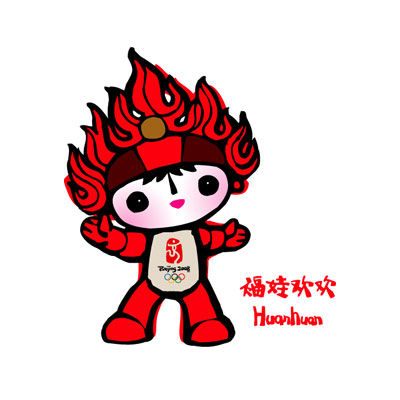 In the intimate
circle of Fuwa, Huanhuan is the big brother. He is a child of fire, symbolizing
the Olympic Flame and the passion of sport -- and passion is the blessing he
bestows. Huanhuan stands in the center of Fuwa as the core embodiment of the
Olympic spirit. And while he inspires all with the passion to run faster, jump
higher and be stronger, he is also open and inviting. Wherever the light of
Huanhuan shines, the inviting warmth of Beijing 2008 -- and the wishful
blessings of the Chinese people -- can be felt. The fiery designs of his head
ornament are drawn from the famed Dunhuang murals -- with just a touch of
China's traditional lucky designs. Huanhuan is outgoing and enthusiastic. He
excels at all the ball games and represents the red Olympic ring. In the intimate
circle of Fuwa, Huanhuan is the big brother. He is a child of fire, symbolizing
the Olympic Flame and the passion of sport -- and passion is the blessing he
bestows. Huanhuan stands in the center of Fuwa as the core embodiment of the
Olympic spirit. And while he inspires all with the passion to run faster, jump
higher and be stronger, he is also open and inviting. Wherever the light of
Huanhuan shines, the inviting warmth of Beijing 2008 -- and the wishful
blessings of the Chinese people -- can be felt. The fiery designs of his head
ornament are drawn from the famed Dunhuang murals -- with just a touch of
China's traditional lucky designs. Huanhuan is outgoing and enthusiastic. He
excels at all the ball games and represents the red Olympic ring.
 Like all
antelopes, Yingying is fast and agile and can swiftly cover great stretches of
land as he races across the earth. A symbol of the vastness of China's
landscape, the antelope carries the blessing of health, the strength of body
that comes from harmony with nature. Yingying's flying pose captures the essence
of a species unique to the Qinghai-Tibet Plateau, one of the first animals put
under protection in China. The selection of the Tibetan Antelope reflects
Beijing's commitment to a Green Olympics. His head ornament incorporates several
decorative styles from the Qinghai-Tibet and Sinkiang cultures and the ethnic
design traditions of Western China. Strong in track and field events, Yingying
is a quick-witted and agile boy who represents the yellow Olympic ring. Like all
antelopes, Yingying is fast and agile and can swiftly cover great stretches of
land as he races across the earth. A symbol of the vastness of China's
landscape, the antelope carries the blessing of health, the strength of body
that comes from harmony with nature. Yingying's flying pose captures the essence
of a species unique to the Qinghai-Tibet Plateau, one of the first animals put
under protection in China. The selection of the Tibetan Antelope reflects
Beijing's commitment to a Green Olympics. His head ornament incorporates several
decorative styles from the Qinghai-Tibet and Sinkiang cultures and the ethnic
design traditions of Western China. Strong in track and field events, Yingying
is a quick-witted and agile boy who represents the yellow Olympic ring.
 Every
spring and summer, the children of Beijing have flown beautiful kites on the
currents of wind that blow through the capital. Among the kite designs, the
golden-winged swallow is traditionally one of the most popular. Nini's
figure is drawn from this grand tradition of flying designs. Her golden
wings symbolize the infinite sky and spread good-luck as a blessing wherever
she flies. Swallow is also pronounced "yan" in Chinese, and Yanjing is what
Beijing was called as an ancient capital city. Among Fuwa, Nini is as
innocent and joyful as a swallow. She is strong in gymnastics and represents
the green Olympic ring. Every
spring and summer, the children of Beijing have flown beautiful kites on the
currents of wind that blow through the capital. Among the kite designs, the
golden-winged swallow is traditionally one of the most popular. Nini's
figure is drawn from this grand tradition of flying designs. Her golden
wings symbolize the infinite sky and spread good-luck as a blessing wherever
she flies. Swallow is also pronounced "yan" in Chinese, and Yanjing is what
Beijing was called as an ancient capital city. Among Fuwa, Nini is as
innocent and joyful as a swallow. She is strong in gymnastics and represents
the green Olympic ring.


Lesson 10
Beijing
Olympics Songs
EVERYONE
IS NO 1
http://www.imeem.com/aensuryanto/video/46NvmLGf/andy_lau_everyone_is_no_1_andy_lau_music_video/
Everyone Is No.1
劉德華
我的路
不是
你的路
我的苦
不是
你的苦
每個人都有潛在的能力
把一切去征服
我的淚
不是
你的淚
我的痛
不是
你的痛
一樣的天空
不同的光榮
有一樣的感動
不需要
自怨自艾的惶恐 只需要沉著
只要向前衝
告訴自己
天生我才必有用
Everyone is No. 1
只要你凡事不問能不能 用一口氣交換你一生
要迎接未來
不必等
Everyone is No. 1
成功的秘訣在你肯不肯 流最熱的汗擁最真的心
第一名屬於每個人 我的手不是
你的手
我的口不是
你的口 只要一條心 狂風和暴雨 都變成好朋友
不需要
自怨自艾的惶恐 只需要沉著
只要向前衝
告訴自己
天生我才必有用
Everyone is No. 1
只要你凡事不問能不能 用一口氣交換你一生
要迎接未來
不必等
Everyone is No. 1
成功的秘訣在你肯不肯 流最熱的汗擁最真的心
第一名屬於每個人 不害怕路上有多冷
直到還有一點餘溫我也會
努力狂奔

Beijing Huan Ying Ni
迎接另一个晨曦,带来全新空气。
气息改变情味不变,茶香飘满情谊。.
我家大门常打开,开放怀抱等你。
拥抱过就有了默契,你就会爱上这里。
不管远近都是客人,请不用客气。
相约好了在一起,我们欢迎你。
我家种着万年青,开放每段传奇。
为传统的土壤播种,为你留下回忆。
陌生熟悉都是客人,请不用拘礼。
第几次来没关系,有太多话题。.
北京欢迎你,为你开天辟地。
流动中的魅力,充满着朝气。
北京欢迎你,在太阳下分享呼吸。
在黄土地刷新成绩!
我家大门常打开,开怀容纳天地。
岁月绽放青春笑容,迎接这个日期。
天大地大都是朋友,请不用客气。
画意诗意带笑意,只为等待你。
北京欢迎你,像音乐感动你。
让我们都加油去超越自己。
北京欢迎你,有梦想谁都了不起。
有勇气就会有奇迹。
北京欢迎你,为你开天辟地。
流动中的魅力,充满着朝气。
北京欢迎你,在太阳下分享呼吸。
在黄土地刷新成绩!
北京欢迎你,像音乐感动你。
让我们都加油去超越自己。
北京欢迎你
北京欢迎你,有梦想谁都了不起。
有勇气就会有奇迹。
我家大门常打开,开放怀抱等你。
拥抱过就有了默契,你就会爱上这里。
不管远近都是客人,请不用客气。
相约好了在一起,我们欢迎你。
北京欢迎你,为你开天辟地。
流动中的魅力,充满着朝气。
北京欢迎你,在太阳下分享呼吸。
在黄土地刷新成绩!
我家大门常打开,开怀容纳天地。
岁月绽放青春笑容,迎接这个日期。
天大地大都是朋友,请不用客气。
画意诗意带笑意,只为等待你。
北京欢迎你,像音乐感动你。
让我们都加油去超越自己。
北京欢迎你,有梦想谁都了不起。
有勇气就会有奇迹。
北京欢迎你,为你开天辟地。
流动中的魅力,充满着朝气。
北京欢迎你,在太阳下分享呼吸。
在黄土地刷新成绩!
北京欢迎你,像音乐感动你。
让我们都加油去超越自己。
北京欢迎你,有梦想谁都了不起。
有勇气就会有奇迹。
北京欢迎你,有梦想谁都了不起。
有勇气就会有奇迹。
北京欢迎你,有梦想谁都了不起。
有勇气就会有奇迹!

Zhan Qi Lai
站起来 -
成龙/王力宏/孙燕姿/韩红
站起来 我的爱牵着山脉
奔跑才有了期待
起点写着我的未来 Hey ya..Hey ya..
终点没有成与败
站起来 我的爱拥抱大海
超越不只是现在
跑过的精彩 依然在 Hey ya..Hey ya..
泪水是 胜利感慨 Hey ya..
多少风雨的等待
穿越心灵 彩虹告诉我的存在
生命真实喝彩
我和你的崇拜
希望看见英雄 奇迹般的色彩
多少梦想的主宰
勇敢和我一起 用心赢回真爱
彼此距离不在
你和我的竞赛
站起来终点没了 起点也会在
站起来 我的爱牵着山脉
奔跑才有了期待
起点写着我的未来 Hey ya..Hey ya..
终点没有成与败
站起来 我的爱拥抱大海
超越不只是现在
跑过的精彩 依然在 Hey ya..Hey ya..
泪水是 胜利感慨Hey ya..Hey ya..
多少风雨的等待
穿越心灵彩虹告诉我的存在
生命真实喝彩 我和你的崇拜
希望看见英雄 奇迹般的色彩
多少梦想的主宰
勇敢和我一起 用心赢回真爱
彼此距离不在 你和我的竞赛
站起来终点没了 起点也会在
多少梦想的主宰
勇敢和我一起 用心赢回真爱
彼此距离不在
你和我的竞赛
站起来终点没了 起点也会在
站起来 我的爱牵着山脉
奔跑才有了期待
起点写着我的未来 Hey ya..Hey ya..
终点没有成与败
站起来 我的爱拥抱大海
超越不只是现在
跑过的精彩 依然在 Hey ya..Hey ya..
泪水是 胜利感慨
Hey ya..Hey ya..Hey ya..Hey ya..

 CLICK
BALL TO GO BACK TO LESSONS CLICK
BALL TO GO BACK TO LESSONS 
|



















































 In the intimate
circle of Fuwa, Huanhuan is the big brother. He is a child of fire, symbolizing
the Olympic Flame and the passion of sport -- and passion is the blessing he
bestows. Huanhuan stands in the center of Fuwa as the core embodiment of the
Olympic spirit. And while he inspires all with the passion to run faster, jump
higher and be stronger, he is also open and inviting. Wherever the light of
Huanhuan shines, the inviting warmth of Beijing 2008 -- and the wishful
blessings of the Chinese people -- can be felt. The fiery designs of his head
ornament are drawn from the famed Dunhuang murals -- with just a touch of
China's traditional lucky designs. Huanhuan is outgoing and enthusiastic. He
excels at all the ball games and represents the red Olympic ring.
In the intimate
circle of Fuwa, Huanhuan is the big brother. He is a child of fire, symbolizing
the Olympic Flame and the passion of sport -- and passion is the blessing he
bestows. Huanhuan stands in the center of Fuwa as the core embodiment of the
Olympic spirit. And while he inspires all with the passion to run faster, jump
higher and be stronger, he is also open and inviting. Wherever the light of
Huanhuan shines, the inviting warmth of Beijing 2008 -- and the wishful
blessings of the Chinese people -- can be felt. The fiery designs of his head
ornament are drawn from the famed Dunhuang murals -- with just a touch of
China's traditional lucky designs. Huanhuan is outgoing and enthusiastic. He
excels at all the ball games and represents the red Olympic ring. Like all
antelopes, Yingying is fast and agile and can swiftly cover great stretches of
land as he races across the earth. A symbol of the vastness of China's
landscape, the antelope carries the blessing of health, the strength of body
that comes from harmony with nature. Yingying's flying pose captures the essence
of a species unique to the Qinghai-Tibet Plateau, one of the first animals put
under protection in China. The selection of the Tibetan Antelope reflects
Beijing's commitment to a Green Olympics. His head ornament incorporates several
decorative styles from the Qinghai-Tibet and Sinkiang cultures and the ethnic
design traditions of Western China. Strong in track and field events, Yingying
is a quick-witted and agile boy who represents the yellow Olympic ring.
Like all
antelopes, Yingying is fast and agile and can swiftly cover great stretches of
land as he races across the earth. A symbol of the vastness of China's
landscape, the antelope carries the blessing of health, the strength of body
that comes from harmony with nature. Yingying's flying pose captures the essence
of a species unique to the Qinghai-Tibet Plateau, one of the first animals put
under protection in China. The selection of the Tibetan Antelope reflects
Beijing's commitment to a Green Olympics. His head ornament incorporates several
decorative styles from the Qinghai-Tibet and Sinkiang cultures and the ethnic
design traditions of Western China. Strong in track and field events, Yingying
is a quick-witted and agile boy who represents the yellow Olympic ring. 